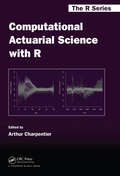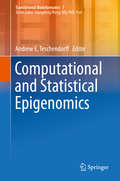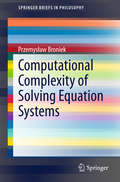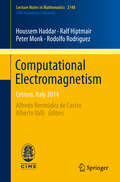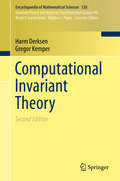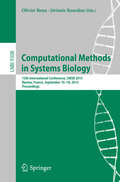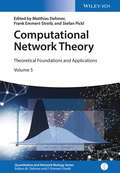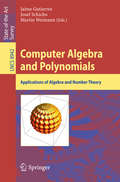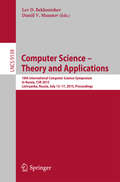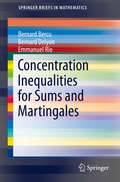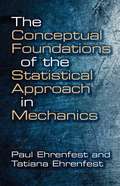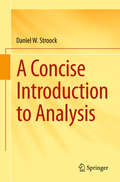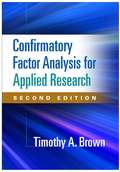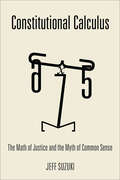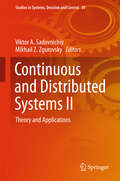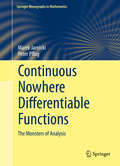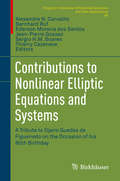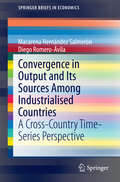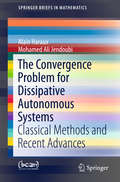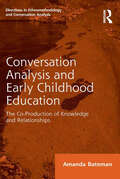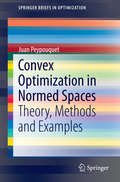- Table View
- List View
Computational Actuarial Science with R (Chapman And Hall/crc The R Ser. #17)
by Arthur CharpentierA Hands-On Approach to Understanding and Using Actuarial ModelsComputational Actuarial Science with R provides an introduction to the computational aspects of actuarial science. Using simple R code, the book helps you understand the algorithms involved in actuarial computations. It also covers more advanced topics, such as parallel computing and C/
Computational and Statistical Epigenomics (Translational Bioinformatics #7)
by Andrew E. TeschendorffThis book introduces the reader to modern computational and statistical tools for translational epigenomics research. Over the last decade, epigenomics has emerged as a key area of molecular biology, epidemiology and genome medicine. Epigenomics not only offers us a deeper understanding of fundamental cellular biology, but also provides us with the basis for an improved understanding and management of complex diseases. From novel biomarkers for risk prediction, early detection, diagnosis and prognosis of common diseases, to novel therapeutic strategies, epigenomics is set to play a key role in the personalized medicine of the future. In this book we introduce the reader to some of the most important computational and statistical methods for analyzing epigenomic data, with a special focus on DNA methylation. Topics include normalization, correction for cellular heterogeneity, batch effects, clustering, supervised analysis and integrative methods for systems epigenomics. This book will be of interest to students and researchers in bioinformatics, biostatistics, biologists and clinicians alike. Dr. Andrew E. Teschendorff is Head of the Computational Systems Genomics Lab at the CAS-MPG Partner Institute for Computational Biology, Shanghai, China, as well as an Honorary Research Fellow at the UCL Cancer Institute, University College London, UK.
Computational Complexity of Solving Equation Systems (SpringerBriefs in Philosophy)
by Przemysław BroniekThis volume considers the computational complexity of determining whether a system of equations over a fixed algebra A has a solution. It examines in detail the two problems this leads to: SysTermSat(A) and SysPolSat(A), in which equations are built out of terms or polynomials, respectively. The book characterizes those algebras for which SysPolSat can be solved in a polynomial time. So far, studies and their outcomes have not covered algebras that generate a variety admitting type 1 in the sense of Tame Congruence Theory. Since unary algebras admit only type 1, this book focuses on these algebras to tackle the main problem. It discusses several aspects of unary algebras and proves that the Constraint Satisfaction Problem for relational structures is polynomially equivalent to SysTermSat over unary algebras. The book's final chapters discuss partial characterizations, present conclusions, and describe the problems that are still open.
Computational Electromagnetism: Cetraro, Italy 2014 (Lecture Notes in Mathematics #2148)
by Houssem Haddar Ralf Hiptmair Peter Monk Rodolfo RodríguezAlfredo Bermúdez Castro Alberto ValliPresenting topics that have not previously been contained in a single volume, this book offers an up-to-date review of computational methods in electromagnetism, with a focus on recent results in the numerical simulation of real-life electromagnetic problems and on theoretical results that are useful in devising and analyzing approximation algorithms. Based on four courses delivered in Cetraro in June 2014, the material covered includes the spatial discretization of Maxwell's equations in a bounded domain, the numerical approximation of the eddy current model in harmonic regime, the time domain integral equation method (with an emphasis on the electric-field integral equation) and an overview of qualitative methods for inverse electromagnetic scattering problems. Assuming some knowledge of the variational formulation of PDEs and of finite element/boundary element methods, the book is suitable for PhD students and researchers interested in numerical approximation of partial differential equations and scientific computing.
Computational Invariant Theory (Encyclopaedia of Mathematical Sciences #130)
by Harm Derksen Gregor KemperThis book is about the computational aspects of invariant theory. Of central interest is the question how the invariant ring of a given group action can be calculated. Algorithms for this purpose form the main pillars around which the book is built. There are two introductory chapters, one on Gröbner basis methods and one on the basic concepts of invariant theory, which prepare the ground for the algorithms. Then algorithms for computing invariants of finite and reductive groups are discussed. Particular emphasis lies on interrelations between structural properties of invariant rings and computational methods. Finally, the book contains a chapter on applications of invariant theory, covering fields as disparate as graph theory, coding theory, dynamical systems, and computer vision. The book is intended for postgraduate students as well as researchers in geometry, computer algebra, and, of course, invariant theory. The text is enriched with numerous explicit examples which illustrate the theory and should be of more than passing interest. More than ten years after the first publication of the book, the second edition now provides a major update and covers many recent developments in the field. Among the roughly 100 added pages there are two appendices, authored by Vladimi r Popov, and an addendum by Norbert A'Campo and Vladimir Popov.
Computational Methods in Systems Biology: 13th International Conference, CMSB 2015, Nantes, France, September 16-18, 2015, Proceedings (Lecture Notes in Computer Science #9308)
by Olivier Roux Jérémie BourdonThis book constitutes the refereed proceedings of the 13th International Conference on Computational Methods in Systems Biology, CMSB 2015, held in Nantes, France, in September 2015. The 20 full papers and 2 short papers presented were carefully reviewed and selected from 43 full and 4 short paper submissions. The papers cover a wide range of topics in the analysis of biological systems, networks and data such as model checking, stochastic analysis, hybrid systems, circadian clock, time series data, logic programming, and constraints solving ranging from intercellular to multiscale.
Computational Network Theory
by Frank Emmert-Streib Matthias Dehmer Stefan PicklThis comprehensive introduction to computational network theory as a branch of network theory builds on the understanding that such networks are a tool to derive or verify hypotheses by applying computational techniques to large scale network data.The highly experienced team of editors and high-profile authors from around the world present and explain a number of methods that are representative of computational network theory, derived from graph theory, as well as computational and statistical techniques. With its coherent structure and homogenous style, this reference is equally suitable for courses on computational networks.
Computer Algebra and Polynomials: Applications of Algebra and Number Theory (Lecture Notes in Computer Science #8942)
by Jaime Gutierrez Josef Schicho Martin WeimannAlgebra and number theory have always been counted among the most beautiful mathematical areas with deep proofs and elegant results. However, for a long time they were not considered that important in view of the lack of real-life applications. This has dramatically changed: nowadays we find applications of algebra and number theory frequently in our daily life. This book focuses on the theory and algorithms for polynomials over various coefficient domains such as a finite field or ring. The operations on polynomials in the focus are factorization, composition and decomposition, basis computation for modules, etc. Algorithms for such operations on polynomials have always been a central interest in computer algebra, as it combines formal (the variables) and algebraic or numeric (the coefficients) aspects. The papers presented were selected from the Workshop on Computer Algebra and Polynomials, which was held in Linz at the Johann Radon Institute for Computational and Applied Mathematics (RICAM) during November 25-29, 2013, at the occasion of the Special Semester on Applications of Algebra and Number Theory.
Computer Science -- Theory and Applications: 10th International Computer Science Symposium in Russia, CSR 2015, Listvyanka, Russia, July 13-17, 2015, Proceedings (Lecture Notes in Computer Science #9139)
by Lev D. Beklemishev Daniil V. MusatovThis book constitutes the proceedings of the 10th International Computer Science Symposium in Russia, CSR 2015, held in Listvyanka, Russia, in July 2015. The 25 full papers presented in this volume were carefully reviewed and selected from 61 submissions. In addition the book contains 4 invited lectures. The scope of the proposed topics is quite broad and covers a wide range of areas in theoretical computer science and its applications.
Concentration Inequalities for Sums and Martingales (SpringerBriefs in Mathematics)
by Bernard Bercu Bernard Delyon Emmanuel RioThe purpose of this book is to provide an overview of historical and recent results on concentration inequalities for sums of independent random variables and for martingales. The first chapter is devoted to classical asymptotic results in probability such as the strong law of large numbers and the central limit theorem. Our goal is to show that it is really interesting to make use of concentration inequalities for sums and martingales. The second chapter deals with classical concentration inequalities for sums of independent random variables such as the famous Hoeffding, Bennett, Bernstein and Talagrand inequalities. Further results and improvements are also provided such as the missing factors in those inequalities. The third chapter concerns concentration inequalities for martingales such as Azuma-Hoeffding, Freedman and De la Pena inequalities. Several extensions are also provided. The fourth chapter is devoted to applications of concentration inequalities in probability and statistics.
The Conceptual Foundations of the Statistical Approach in Mechanics (Dover Books on Physics)
by Paul Ehrenfest Tatiana EhrenfestIn this concise classic, Paul Ehrenfest - one of the twentieth century's greatest physicists - reformulated the foundations of the statistical approach in mechanics. Originally published in 1912, this classic has lost little of its scientific and didactic value, and is suitable for advanced undergraduate and graduate students of physics and historians of science.Part One describes the older formulation of statistico-mechanical investigations (kineto-statistics of the molecule). Part Two takes up the modern formulation of kineto-statistics of the gas model, and Part Three explores W. B. Gibbs's major work, Elementary Principles in Statistical Mechanics and its coverage of such topics as the problem of axiomatization in kineto-statistics, the introduction of canonical and microcanonical distributions, and the analogy to the observable behavior of thermodynamic systems. The book concludes with the authors' original notes, a series of useful appendixes, and a helpful bibliography.
A Concise Introduction to Analysis
by Daniel W. StroockThis book provides an introduction to the basic ideas and tools used in mathematical analysis. It is a hybrid cross between an advanced calculus and a more advanced analysis text and covers topics in both real and complex variables. Considerable space is given to developing Riemann integration theory in higher dimensions, including a rigorous treatment of Fubini's theorem, polar coordinates and the divergence theorem. These are used in the final chapter to derive Cauchy's formula, which is then applied to prove some of the basic properties of analytic functions. Among the unusual features of this book is the treatment of analytic function theory as an application of ideas and results in real analysis. For instance, Cauchy's integral formula for analytic functions is derived as an application of the divergence theorem. The last section of each chapter is devoted to exercises that should be viewed as an integral part of the text. A Concise Introduction to Analysis should appeal to upper level undergraduate mathematics students, graduate students in fields where mathematics is used, as well as to those wishing to supplement their mathematical education on their own. Wherever possible, an attempt has been made to give interesting examples that demonstrate how the ideas are used and why it is important to have a rigorous grasp of them.
A Concise Text on Advanced Linear Algebra
by Yisong YangThis engaging textbook for advanced undergraduate students and beginning graduates covers the core subjects in linear algebra. The author motivates the concepts by drawing clear links to applications and other important areas, such as differential topology and quantum mechanics. The book places particular emphasis on integrating ideas from analysis wherever appropriate. For example, the notion of determinant is shown to appear from calculating the index of a vector field which leads to a self-contained proof of the Fundamental Theorem of Algebra, and the Cayley–Hamilton theorem is established by recognizing the fact that the set of complex matrices of distinct eigenvalues is dense. The material is supplemented by a rich collection of over 350 mostly proof-oriented exercises, suitable for students from a wide variety of backgrounds. Selected solutions are provided at the back of the book, making it suitable for self-study as well as for use as a course text.
Confirmatory Factor Analysis For Applied Research (Methodology In The Social Sciences)
by Timothy A. BrownWith its emphasis on practical and conceptual aspects, rather than mathematics or formulas, this accessible book has established itself as the go-to resource on confirmatory factor analysis (CFA). Detailed, worked-through examples drawn from psychology, management, and sociology studies illustrate the procedures, pitfalls, and extensions of CFA methodology. The text shows how to formulate, program, and interpret CFA models using popular latent variable software packages (LISREL, Mplus, EQS, SAS/CALIS); understand the similarities and differences between CFA and exploratory factor analysis (EFA); and report results from a CFA study. It is filled with useful advice and tables that outline the procedures. The companion website (www.guilford.com/brown3-materials) offers data and program syntax files for most of the research examples, as well as links to CFA-related resources. New to This Edition *Updated throughout to incorporate important developments in latent variable modeling. *Chapter on Bayesian CFA and multilevel measurement models. *Addresses new topics (with examples): exploratory structural equation modeling, bifactor analysis, measurement invariance evaluation with categorical indicators, and a new method for scaling latent variables. *Utilizes the latest versions of major latent variable software packages.
Constitutional Calculus: The Math of Justice and the Myth of Common Sense
by Jeff SuzukiHow math trumps tradition in promoting justice, fairness, and a more stable democracy.How should we count the population of the United States? What would happen if we replaced the electoral college with a direct popular vote? What are the consequences of allowing unlimited partisan gerrymandering of congressional districts? Can six-person juries yield verdicts consistent with the needs of justice? Is it racist to stop and frisk minorities at a higher rate than non-minorities? These and other questions have long been the subject of legal and political debate and are routinely decided by lawyers, politicians, judges, and voters, mostly through an appeal to common sense and tradition.But mathematician Jeff Suzuki asserts that common sense is not so common, and traditions developed long ago in what was a mostly rural, mostly agricultural, mostly isolated nation of three million might not apply to a mostly urban, mostly industrial, mostly global nation of three hundred million. In Constitutional Calculus, Suzuki guides us through the U.S. Constitution and American history to show how mathematics reveals our flaws, finds the answers we need, and moves us closer to our ideals. From the first presidential veto to the debate over mandatory drug testing, the National Security Agency's surveillance program, and the fate of death row inmates, Suzuki draws us into real-world debates and then reveals how math offers a superior compass for decision-making. Relying on iconic cases, including the convictions of the Scottsboro boys, League of United Latin American Citizens v. Perry, and Floyd v. City of New York, Suzuki shows that more math can lead to better justice, greater fairness, and a more stable democracy. Whether you are fascinated by history, math, social justice, or government, your interest will be piqued and satisfied by the convincing case Suzuki makes.
Constitutional Calculus: The Math of Justice and the Myth of Common Sense
by Jeff SuzukiHow math can make a more stable democracy: &“A breath of fresh air . . . a reaffirmation that mathematics should be used more often to make general public policy.&” —MAA Reviews How should we count the population of the United States? What would happen if we replaced the electoral college with a direct popular vote? What are the consequences of allowing unlimited partisan gerrymandering of congressional districts? Can six-person juries yield verdicts consistent with the needs of justice? Is it racist to stop and frisk minorities at a higher rate than non-minorities? These and other questions have long been the subject of legal and political debate and are routinely decided by lawyers, politicians, judges, and voters, mostly through an appeal to common sense and tradition. But mathematician Jeff Suzuki asserts that common sense is not so common, and traditions developed long ago in what was a mostly rural, mostly agricultural, mostly isolated nation of three million might not apply to a mostly urban, mostly industrial, mostly global nation of three hundred million. In Constitutional Calculus, Suzuki guides us through the U.S. Constitution and American history to show how mathematics reveals our flaws, finds the answers we need, and moves us closer to our ideals. From the first presidential veto to the debate over mandatory drug testing, the NSA&’s surveillance program, and the fate of death row inmates, Suzuki draws us into real-world debates and then reveals how math offers a superior compass for decision-making. Relying on iconic cases, including the convictions of the Scottsboro boys, League of United Latin American Citizens v. Perry, and Floyd v. City of New York, Suzuki shows that more math can lead to better justice, greater fairness, and a more stable democracy.
Continuous and Distributed Systems II: Theory and Applications (Studies in Systems, Decision and Control #30)
by Mikhail Z. Zgurovsky Viktor A. SadovnichiyAs in the previous volume on the topic, the authors close the gap between abstract mathematical approaches, such as applied methods of modern algebra and analysis, fundamental and computational mechanics, nonautonomous and stochastic dynamical systems, on the one hand, and practical applications in nonlinear mechanics, optimization, decision making theory and control theory on the other. Readers will also benefit from the presentation of modern mathematical modeling methods for the numerical solution of complicated engineering problems in biochemistry, geophysics, biology and climatology. This compilation will be of interest to mathematicians and engineers working at the interface of these field. It presents selected works of the joint seminar series of Lomonosov Moscow State University and the Institute for Applied System Analysis at National Technical University of Ukraine "Kyiv Polytechnic Institute". The authors come from Brazil, Germany, France, Mexico, Spain, Poland, Russia, Ukraine, and the USA.
Continuous Nowhere Differentiable Functions: The Monsters Of Analysis (Springer Monographs in Mathematics)
by Marek Jarnicki Peter PflugThis book covers the construction, analysis, and theory of continuous nowhere differentiable functions, comprehensively and accessibly. After illuminating the significance of the subject through an overview of its history, the reader is introduced to the sophisticated toolkit of ideas and tricks used to study the explicit continuous nowhere differentiable functions of Weierstrass, Takagi-van der Waerden, Bolzano, and others. Modern tools of functional analysis, measure theory, and Fourier analysis are applied to examine the generic nature of continuous nowhere differentiable functions, as well as linear structures within the (nonlinear) space of continuous nowhere differentiable functions. To round out the presentation, advanced techniques from several areas of mathematics are brought together to give a state-of-the-art analysis of Riemann's continuous, and purportedly nowhere differentiable, function. For the reader's benefit, claims requiring elaboration, and open problems, are clearly indicated. An appendix conveniently provides background material from analysis and number theory, and comprehensive indices of symbols, problems, and figures enhance the book's utility as a reference work. Students and researchers of analysis will value this unique book as a self-contained guide to the subject and its methods.
Contributions to Nonlinear Elliptic Equations and Systems: A Tribute to Djairo Guedes de Figueiredo on the Occasion of his 80th Birthday (Progress in Nonlinear Differential Equations and Their Applications #86)
by Alexandre N. Carvalho Bernhard Ruf Ederson Moreira Santos Jean-Pierre Gossez Sergio H. M. Soares Thierry CazenaveThis volume of contributions pays tribute to the life and work of Djairo Guedes de Figueiredo on the occasion of his 80th birthday. The articles it contains were born out of the ICMC Summer Meeting on Differential Equations - 2014 Chapter, also dedicated to de Figueiredo and held at the Universidade de São Paulo at São Carlos, Brazil from February 3-7, 2014. The contributing authors represent a group of international experts in the field and discuss recent trends and new directions in nonlinear elliptic partial differential equations and systems. Djairo Guedes de Figueiredo has had a very active scientific career, publishing 29 monographs and over one hundred research articles. His influence on Brazilian mathematics has made him one of the pillars of the subject in that country. He had a major impact on the development of analysis, especially in its application to nonlinear elliptic partial differential equations and systems throughout the entire world. The articles collected here pay tribute to him and his legacy and are intended for graduate students and researchers in mathematics and related areas who are interested in nonlinear elliptic partial differential equations and systems.
Convergence in Output and Its Sources Among Industrialised Countries: A Cross-Country Time-Series Perspective (SpringerBriefs in Economics)
by Diego Romero-Ávila Macarena Hernández SalmerónThis book investigates the existence of stochastic and deterministic convergence of real output per worker and the sources of output (physical capital per worker, human capital per worker, total factor productivity -TFP- and average annual hours worked) in 21 OECD countries over the period 1970-2011. Towards this end, the authors apply a large battery of panel unit root and stationarity tests, all of which are robust to the presence of cross-sectional dependence. The evidence fails to provide clear-cut evidence of convergence dynamics either in real GDP per worker or in the series of the sources of output. Due to some limitations associated with second-generation panel unit root and stationarity tests, the authors further use the more flexible PANIC approach which provides evidence that real GDP per worker, real physical capital per worker, human capital and average annual hours exhibit some degree of deterministic convergence, whereas TFP series display a high degree of stochastic convergence.
The Convergence Problem for Dissipative Autonomous Systems
by Alain Haraux Mohamed Ali JendoubiThe book investigates classical and more recent methods of study for the asymptotic behavior of dissipative continuous dynamical systems with applications to ordinary and partial differential equations, the main question being convergence (or not) of the solutions to an equilibrium. After reviewing the basic concepts of topological dynamics and the definition of gradient-like systems on a metric space, the authors present a comprehensive exposition of stability theory relying on the so-called linearization method. For the convergence problem itself, when the set of equilibria is infinite, the only general results that do not require very special features of the non-linearities are presently consequences of a gradient inequality discovered by S. Lojasiewicz. The application of this inequality jointly with the so-called Liapunov-Schmidt reduction requires a rigorous exposition of Semi-Fredholm operator theory and the theory of real analytic maps on infinite dimensional Banach spaces, which cannot be found anywhere in a readily applicable form. The applications covered in this short text are the simplest, but more complicated cases are mentioned in the final chapter, together with references to the corresponding specialized papers.
Conversation Analysis and Early Childhood Education: The Co-Production of Knowledge and Relationships (Directions in Ethnomethodology and Conversation Analysis)
by Amanda BatemanThis book provides insight into the everyday activities co-produced by teachers and young children, demonstrating the fine details of teaching and learning as knowledge is shared through the everyday activities of talk-in-interaction. Adopting an ethnomethodological perspective, together with conversation analysis and membership categorisation analysis, it reveals how teaching and learning are jointly accomplished during activities such as pretend play episodes, during disputes, managing illness and talking about the environment. Through in-depth studies of child-teacher interactions, the book explores the means by which knowledge is transferred and episodes of teaching and learning are co-constructed by participants, shedding light on the co-production of social order, the communication of knowledge and manner in which professional and relational identities are made relevant in interaction. As such, Conversation Analysis and Early Childhood Education will be of interest not only to scholars of ethnomethodology and conversation analysis, but also to those working in the areas of early childhood studies and pedagogy.
Convex Optimization in Normed Spaces: Theory, Methods and Examples (SpringerBriefs in Optimization #0)
by Juan PeypouquetThis work is intended to serve as a guide for graduate students and researchers who wish to get acquainted with the main theoretical and practical tools for the numerical minimization of convex functions on Hilbert spaces. Therefore, it contains the main tools that are necessary to conduct independent research on the topic. It is also a concise, easy-to-follow and self-contained textbook, which may be useful for any researcher working on related fields, as well as teachers giving graduate-level courses on the topic. It will contain a thorough revision of the extant literature including both classical and state-of-the-art references.
Convex Optimization of Power Systems
by Joshua Adam TaylorOptimization is ubiquitous in power system engineering. Drawing on powerful, modern tools from convex optimization, this rigorous exposition introduces essential techniques for formulating linear, second-order cone, and semidefinite programming approximations to the canonical optimal power flow problem, which lies at the heart of many different power system optimizations. Convex models in each optimization class are then developed in parallel for a variety of practical applications like unit commitment, generation and transmission planning, and nodal pricing. Presenting classical approximations and modern convex relaxations side-by-side, and a selection of problems and worked examples, this is an invaluable resource for students and researchers from industry and academia in power systems, optimization, and control.
Core Connections Integrated II
by Leslie DietikerCore Connections Integrated II Core Connections Integrated II is the second course in a five-year sequence of college preparatory mathematics courses that starts with Core Connections Integrated I and continues through Calculus Third Edition. It aims to formalize and extend the geometry that students have learned in previous courses. It does this by focusing on establishing triangle congruence criteria using rigid motions and formal constructions and building a formal understanding of similarity based on dilations and proportional reasoning. It also helps students develop the concepts of formal proof, explore the properties of two- and three-dimensional objects, work within the rectangular coordinate system to verify geometric relationships and prove basic theorems about circles. Students also use the language of set theory to compute and interpret probabilities for compound events. On a daily basis, students in Core Connections Integrated II use problem-solving strategies, questioning, investigating, analyzing critically, gathering and constructing evidence, and communicating rigorous arguments justifying their thinking. Under teacher guidance, students learn in collaboration with others while sharing information, expertise, and ideas.
